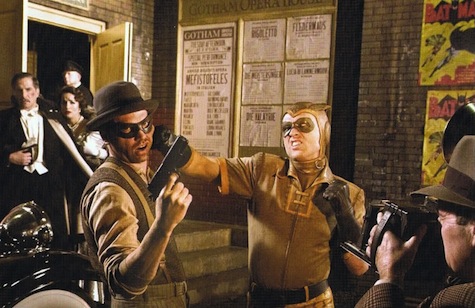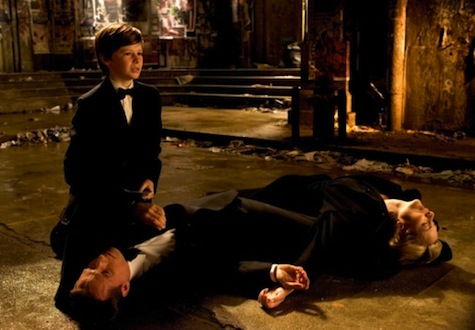It’s one of the seminal moments in superhero tales, the near-legendary incident that we’ve seen repeated countless times with little variation. It’s less than two minutes, but the repercussions are transformative.
In case you haven’t seen it enough times, here’s a supercut of Bruce Wayne’s parents dying.
The key elements never change: Coming home from the opera; a shady robber with a gun; the strand of pearls flying everywhere (looking especially poetic in the animated take on The Dark Knight Returns); poor little Bruce spared for some reason. We’ve even seen it make for some pretty excellent cosplay.
Will we ever see this scene altered? Probably not. That’s clearly not the case for FOX’s new Batman prequel series Gotham (read our review of the pilot) although it’s interesting that the Gotham version seems to be the only one where child Bruce Wayne actually reacts like a child would. It’s become too much of a shorthand, at this point—so much so that we totally got that Watchmen Easter egg based on visuals alone.

Come to think of it, it’s the one time that Thomas and Martha Wayne don’t get gunned down in the street. But then we get Nite Owl instead of Batman and…that doesn’t turn out so well.
Via Vulture. Photos: Warner Bros.











Actually it was only the opera in Batman Begins. Historically, they were coming home from an unspecified movie. The first screen adaptation, the 1985 Super Powers Team episode “The Fear,” written by future Batman: TAS producer Alan Burnett (in the lower left corner of the video), made it Robin Hood (presumably to explain his later choice of sidekick name); the following year, Frank Miller’s The Dark Knight Returns made it The Mark of Zorro, which has been the standard in most instances since then.
The supercut is missing the second-most recent dramatization of the origin, a flashback in the Beware the Batman episode “Monsters.” It’s also missing the fantasy sequence in Justice League Unlimited‘s “For the Man Who Has Everything,” where Bruce imagines Thomas Wayne overpowering the gunman and beating him brutally. Since that one didn’t really happen, maybe it doesn’t quite count — but it’s the closest thing in the DC Animated Universe to a depiction of the Waynes’ murder, since B:TAS was made under severe censorship and could never do more than symbolically allude to the event.
One thing that all the screen adaptations (including the Beware the Batman one) have in common: They make the mistake of interpreting “Crime Alley” as an actual alley, of the sort that a rich couple would have no conceivable reason to take their child into at night. In fact, when Crime Alley was introduced in 1976 in Detective Comics #457 by Denny O’Neil and Dick Giordano, it was introduced thusly:
(That last being the story title. All ellipses are from the original text — I’ve deleted nothing.)
So “Crime Alley” is just a nickname for the street/neighborhood — it’s not a literal alley. The artwork shows that the spot where the killings occurred — or the spot where Batman stops a mugging and gets inordinately angry at the mugger for daring to draw a gun on him there, on the exact spot and anniversary of his parents’ murder — as the sidewalk in front of a row of brownstones, just a couple of doors down from the movie theater (which has become a porno theater in the story’s present day).
Before that, in the original 1939 depiction of Batman’s origin and later in 1948’s “The Origin of Batman,” the murder occurred on a street corner right under a streetlight. So in the comics, it was consistently portrayed for decades as a crime that happened right out in the open, making it all the more shocking and brazen. In O’Neil’s version, the fact that such a brutal crime happens in an upscale neighborhood just adds to the shock, to the extent that it scars the reputation of Park Row forever and triggers its decline into a slum as the well-to-do residents flee. The tendency of TV and movies to put it in a literal back alley, the kind of place where you expect a crime to happen, detracts from that impact, and creates the impression that the Waynes were killed as much through their own carelessness as Joe Chill’s brazenness (of course you should never blame the victim, but the impression exists nonetheless). I wish somebody, for once, would get it right.
@1, In the Arkham games, it’s again depicted as an actual alley. But at least they remembered to put it near the movie theater.
While B:TAS wasn’t able to show the Waynes’ murder, they did have Batman go to Crime Alley at least once on its anniversary. I seem to recall that it was depicted more like a neighborhood rather than one specific alley, but it’s been a long time, so I can’t say for sure.
-Andy
@2: Good point — “Appointment in Crime Alley” (by comics scribe Gerry Conway) portrays it just as O’Neil did, as the former Park Row, now become a slum neighborhood. The actual site of the murder is shown as a sidewalk under an elevated train track. A couple of dozen episodes later (and presumably a year later in story time, since they’re both on the anniversary), “I Am the Night” shows the same, but now the tracks are wider, the sidewalk under them looking darker and more enclosed.
But then there’s the hallucination sequence in “Dreams in Darkness” where Batman sees his parents in a surreal, twisted alley and they then walk into a tunnel that becomes the barrel of a giant revolver. And JLU’s “For the Man Who Has Everything,” supposedly set in the same universe, shows it in Bruce’s memory/dream as an alley directly across the street from the movie theater showing The Mark of Zorro. So that’s another one that gets it wrong. B:TAS is really the only adaptation that followed O’Neil’s intention behind the name “Crime Alley,” and yet it was inconsistent about it, and never actually got to show the murder.
In the Batman and Superman movie Dawn of Justice we once again see the Wayne murders
however this time around it’s seen in slow motion.
@4/Greg White: Snyder’s version is basically a panel-for-panel recreation of Frank Miller’s version from Batman: The Dark Knight Returns, Snyder’s main inspiration for his portrayal of Batman here.
The “Batman: The Brave and the Bold” version is of note because it manages to make the basic story even more depressing – the murders occur on Christmas just after Bruce was a jerk to his parents.